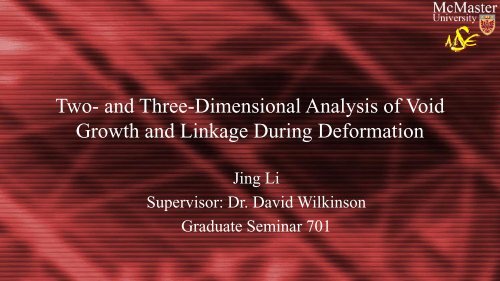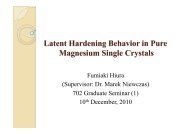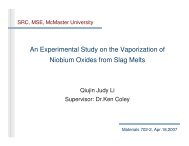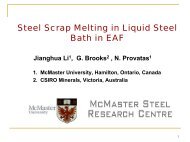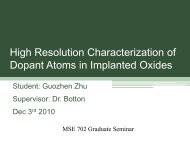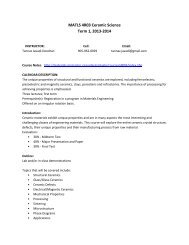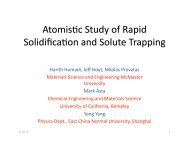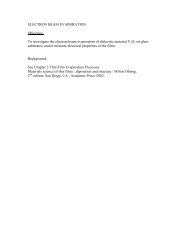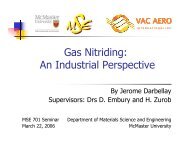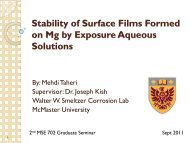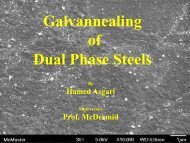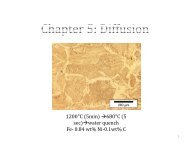Two- and Three-Dimensional Analysis of Void ... - Course Notes
Two- and Three-Dimensional Analysis of Void ... - Course Notes
Two- and Three-Dimensional Analysis of Void ... - Course Notes
You also want an ePaper? Increase the reach of your titles
YUMPU automatically turns print PDFs into web optimized ePapers that Google loves.
<strong>Two</strong>- <strong>and</strong> <strong>Three</strong>-<strong>Dimensional</strong> <strong>Analysis</strong> <strong>of</strong> <strong>Void</strong><br />
Growth <strong>and</strong> Linkage During Deformation<br />
Jing Li<br />
Supervisor: Dr. David Wilkinson<br />
Graduate Seminar 701
Outline<br />
• Introduction <strong>of</strong> Ductile Fracture<br />
• Literature Review <strong>and</strong> Group Research Summary<br />
• Research Objectives<br />
• Experimental Approach<br />
• Preliminary Results<br />
• Summary <strong>and</strong> Future Work<br />
2
Introduction<br />
Deformation<br />
Ductile fracture process:<br />
• <strong>Void</strong> nucleation<br />
• <strong>Void</strong> growth<br />
• <strong>Void</strong> coalescence/linkage<br />
Longitudinal radius<br />
Linkage<br />
<strong>Void</strong> size<br />
Lateral radius<br />
R 0<br />
e coalescence<br />
strain<br />
R 0<br />
coalescence<br />
e coalescence<br />
Linkage<br />
Callister <strong>and</strong> Rethwisch - 2010; Hosokawa - 2010<br />
3
Introduction<br />
<strong>Void</strong> Nucleation Mechanisms:<br />
Decohesion<br />
Particle Cracking<br />
Al 2 O 3 reinforced Al606 (Kanetake et al – 1995)<br />
Loading direction<br />
4
Introduction<br />
<strong>Void</strong> Coalescence Mechanisms:<br />
Internal Necking<br />
<strong>Void</strong> Sheeting<br />
Loading<br />
Direction<br />
Copper (Puttick – 1959) AISI 4340 Steel (Cox & Low – 1974)<br />
5
Literature Review<br />
Local true strain = ln(R/R0)<br />
<strong>Void</strong> Coalescence Models<br />
McClintock – 1968<br />
Coalescence when<br />
voids impinge each other<br />
2R = L<br />
R<br />
2R<br />
Weck - 2008<br />
L<br />
R e 3 31<br />
n <br />
ln sinh <br />
<br />
<br />
<br />
<br />
Far field true strain = ε<br />
R0<br />
2 1<br />
n 2 (Plane strain condition, n – work hardening rate)
Literature Review<br />
<strong>Void</strong> Coalescence Models<br />
Brown & Embury – 1973<br />
R<br />
Coalescence when<br />
void length = intervoid spacing<br />
2<br />
8<br />
2R1 e R<br />
<br />
<br />
<br />
3V<br />
f<br />
3<br />
<br />
<br />
<br />
Weck - 2006<br />
V<br />
f<br />
– Volume fraction
Literature Review<br />
<strong>Void</strong> Coalescence Models<br />
Thomason – 1968, 1990<br />
• plastic limit load condition for<br />
localized plastic failure <strong>of</strong> the<br />
intervoid matrix<br />
• 2D:<br />
0.3A <br />
1<br />
n-2D<br />
<br />
m<br />
1<br />
<br />
0.6 1V<br />
f <br />
a / c1 An-2D<br />
<br />
<br />
Y 2<br />
• 3D:<br />
<br />
<br />
2/3<br />
2<br />
0.1 1.2 1<br />
3<br />
V<br />
<br />
f b <br />
m<br />
1<br />
<br />
2 1/2 1V<br />
f 1 exp( e ) <br />
<br />
<br />
a<br />
/d<br />
b 4 <br />
b0<br />
Y 2<br />
<br />
<br />
<br />
<br />
b<br />
d <br />
8
Research Highlight by Our Group<br />
Loading<br />
Direction<br />
AA 5052<br />
2D-single sheet<br />
Load<br />
Interrupted in situ SEM<br />
Data points <strong>of</strong> SEM<br />
Displacement<br />
Models<br />
McClintock<br />
Brown & Embury<br />
Thomason<br />
Weck, A. <strong>and</strong> Wilkinson D. S. (2008) Acta Materialia 56(8): 1774-1784.<br />
2D-single sheet<br />
×Valid only at low far field strain<br />
√ Excellent for 90°<br />
×Poor for 45°<br />
×Not working<br />
9
Research Highlight by Our Group<br />
Loading<br />
Direction<br />
Cu(99.999%)<br />
3D-single sheet<br />
Load<br />
Interrupted in situ tomography<br />
Data points <strong>of</strong> tomograms<br />
Models 2D-single sheet 3D-single sheet<br />
Brown & Embury √ Excellent for 90° × Not working<br />
Displacement<br />
Thomason<br />
×Not working<br />
√ Excellent for 90°<br />
×Poor for angular configuration<br />
Weck, A., et al. (2008) Acta Materialia 56(12): 2919-2928.<br />
10
Research Summary by Our Group<br />
3D-multiple sheets<br />
Load<br />
Continuous tomography<br />
Displacement<br />
Cu(99.999%)<br />
Hosokawa, A. PhD Thesis, 2010<br />
11
Research Objectives<br />
• Fabricating 2D single-sheet model materials with different angles with<br />
respect to the tensile direction.<br />
• Analyzing the angular effect by two dimensional methods by using in situ<br />
SEM.<br />
• Comparing experimental results with classic models <strong>and</strong> modification.<br />
• Evaluating <strong>of</strong> the competition <strong>of</strong> internal necking <strong>and</strong> shear fracture modes.<br />
• Fabricating 3D model materials <strong>and</strong> Extending to three-dimensional analysis<br />
by using XRCT.<br />
12
Experimental Approach - Sample Preparations<br />
Materials:<br />
• Pure Cu (99.9999%)<br />
• α-brass (70 wt% Cu, 30 wt% Zn)<br />
• GlidCop Al-25 (0.5 wt% Al 2 O 3 , Cu balance)<br />
90°<br />
75°<br />
60°<br />
Loading<br />
Direction<br />
45°<br />
Electrical Discharge Machining<br />
Laser Drilling (KJ Marketing Services company)<br />
13
Experimental Approach<br />
Tensile Test Coupled with Environment Scanning Electron Microscope<br />
Development <strong>of</strong> computer assisted tomography<br />
(Cormack – 1960s & Hounsfield – 1970s)<br />
The Nobel Prize in Physiology or Medicine 1979<br />
X-Ray Computed Tomography (XRCT)<br />
SkyScan @ 1172 high-resolution micro-CT<br />
14
Experimental Approach - XRCT Principles<br />
Radiation<br />
beam<br />
Sample rotated<br />
through 180°<br />
SOURCE SAMPLE DETECTOR<br />
X-Rays<br />
CCD camera<br />
I 0<br />
I t<br />
Absorption<br />
image<br />
projected on<br />
CCD camera<br />
I t = I 0 e -μt<br />
Beer–Lambert law<br />
t – sample thickness<br />
μ- absorption coefficient<br />
2D images<br />
processed to give<br />
3D volume<br />
Hosokawa - 2007<br />
15
Preliminary Results<br />
Brass<br />
• <strong>Void</strong> growth <strong>and</strong> linkage <strong>of</strong> brass 30<br />
Loading<br />
Direction<br />
16
Preliminary Results - Fractography<br />
α-brass<br />
Cu (99.9999%)<br />
GlidCop-Al25<br />
17
Preliminary Results<br />
• <strong>Void</strong> growth <strong>and</strong> linkage process <strong>of</strong> brass-45°(Hole #1 to #4)<br />
Loading<br />
Direction<br />
1<br />
• <strong>Void</strong> growth <strong>and</strong> linkage <strong>of</strong> brass 30<br />
2<br />
3<br />
A1 A2 A3 A4<br />
4<br />
1<br />
2<br />
3<br />
4<br />
5<br />
6<br />
7<br />
8<br />
A5 A6 A7<br />
1<br />
2<br />
3<br />
4<br />
18
4<br />
Preliminary Results<br />
• <strong>Void</strong> growth <strong>and</strong> linkage process <strong>of</strong> brass-45°(Hole #4 to #8)<br />
B1 B2 B3 B4<br />
5<br />
Loading<br />
Direction<br />
6<br />
7<br />
8<br />
B5 B6 B7<br />
1<br />
2<br />
3<br />
4<br />
5<br />
6<br />
7<br />
8<br />
19<br />
19
Preliminary Results<br />
Brass<br />
• XRCT results <strong>of</strong> brass 45<br />
Loading<br />
Direction<br />
20
Preliminary Results<br />
top surface seen in SEM<br />
A<br />
back surface<br />
B<br />
8<br />
7<br />
6<br />
5<br />
4<br />
3<br />
2<br />
1<br />
8<br />
7<br />
6<br />
5<br />
4<br />
3<br />
2<br />
1<br />
Section close to top surface: no Linkage<br />
Section close to the back surface: Linkage!!<br />
21
Preliminary Results<br />
6061 Al alloy reinforced with SiC particles<br />
Buffiere, J. Y., et al. (1999), Acta Materialia 47(5): 1613-1625.<br />
22
Summary<br />
• Classic models cannot give reliable predictions for different type <strong>of</strong><br />
model materials.<br />
• There is limited experimental data for holes with different angle<br />
arrangements.<br />
• Current models don’t treat the effect <strong>of</strong> angular arrangements which is<br />
found to be important from our experimental work.<br />
• <strong>Void</strong> growth <strong>and</strong> linkage in two-dimensional model materials has been<br />
visualized successfully by ESEM coupled with tensile test.<br />
23
Future Work<br />
• Quantitative analysis <strong>of</strong> the 2D experimental results <strong>and</strong> verify classic<br />
models.<br />
• 3D model materials fabrication - Overcoming the delamination <strong>and</strong><br />
alignment problems.<br />
Weck’s delamination problem Hosokawa’s alignment problem My solutions<br />
Hosokawa, A. 2007<br />
24
Acknowledgement<br />
Supervisor:<br />
• Dr. David S. Wilkinson<br />
Group Members:<br />
• Michael Nemcko<br />
• Felicia Annor<br />
• Dr. Yaping Lü<br />
• Dr. Akihide Hosokawa<br />
• Dr. Arnaud Weck<br />
• Dr. Jidong Kang<br />
• Dr. Connie Barry<br />
Technical Support:<br />
• Jim Garret<br />
• Klaus Schultes<br />
• Chris Butcher<br />
• Doug Culley<br />
• Xiaogang Li<br />
• Ed McCaffery<br />
25


